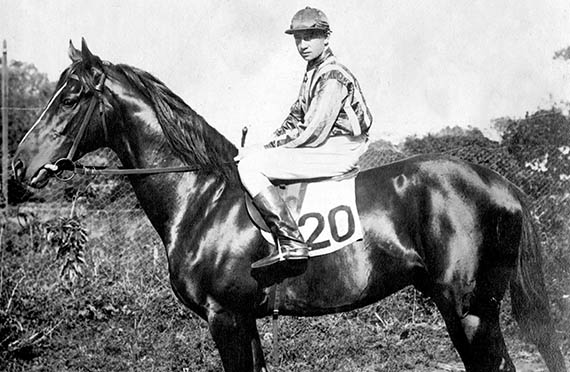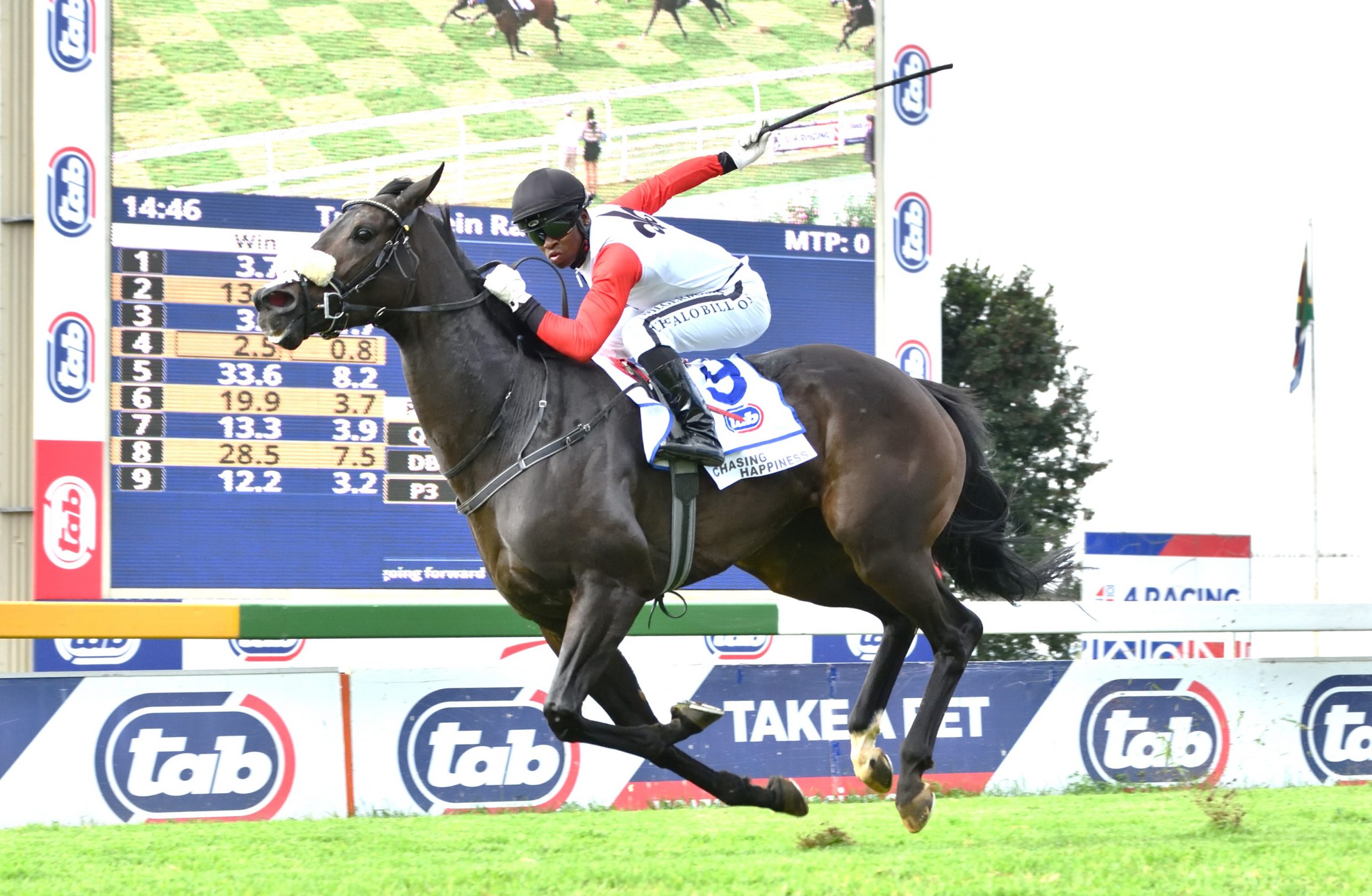
Syd Garrett aboard his first July winner, Goldwing
As time continues its inexorable march, our history retreats ever further into the dusty annals of the ages and links with the greats of yesteryear grow ever more tenuous. Glimpses into the lives and times of racing’s heyday through the eyes of those who experienced them, are incredibly rare and I was therefore thrilled to recently meet Glendyr Pirija, youngest daughter of Syd Garrett, the fabled ‘Wizard of Roamer Lodge’.
Syd is still regarded with awe by many of our modern training legends and counts among his many achievements a staggering 11 victories of what we know today as the J&B Met. Syd Garrett was one of two children, born to a family of Irish origin who ran a hotel in the Eastern Cape town of Uitenhage. Syd’s father (remembered by Glendyr as “Bompa”) used to drive a horse and cart and it seems that that was where Syd’s love for horses originated.
With the sort of flagrant disregard for health, safety and children’s rights that would have modern day UNICEF up in arms, by the time he was eight years old, young Syd was a successful race rider on the local amateur scene. When he was 12 years old, a family friend put in a recommendation to prominent conditioner Jim Russell and young Garrett transferred to the Cape to start his apprenticeship at Russell’s Kenilworth yard.
Riding Success
They forged a formidable partnership, being particularly successful during the Durban racing season and it was during the winter of 1919 that the young jockey was catapulted into the full glare of the national stage when he won the Durban July on a Russell horse named Goldwing. Goldwing was a good horse, but had suffered a lameness in the run-up to the July, which Russell treated with intensive sea water therapy. It worked, Garrett rode a faultless race and they won by a margin of 0.5 lengths.
In the 1920 July, Garrett took the reins on Pamphlet, Russell’s 1918 July winner. Lugging a welterweight of 61kg, they cantered down to the start with a No 1 draw in their favour. However, their tiny advantage evaporated when Pamphlet became unruly and was relegated to 17 by the starter. Nevertheless, his jockey stayed calm under pressure and steered Pamphlet home confidently to an ovation from the stands.
Training career
When Jim Russell decided to go back to England, Garrett exchanged his riding papers for a trainer’s licence and took over the yard. It was not long before he made his presence felt in the conditioning ranks. He was notoriously uncompromising when it came to selecting clients, famously turning down the likes of Charles Engelhard and Abe Bloomberg (his lawyer and guardian to his daughter, Glendyr). Deeming their business relationship to pose a conflict of interest, he recommended Mr Bloomberg to Terrance Millard instead. Garrett did accept the likes of Countess Labia, Warwick Bryant, Piet Louw and Sir Abe Bailey, but even these were managed with a firm hand and only allowed into the yard during very strict visiting hours! However, the regime paid dividends and Garrett landed his first Met in 1926 with Sir W Nelson’s Grand Chase.
But there was more to come, particularly after the yard relocated from Claremont to Milnerton, where the Wizard earned his nickname. The stables were named Roamer Lodge after a grey horse called Roamer. The large grey, who came with a string of unflattering descriptions, had been a bargain buy in England and sent to South Africa by Jim Russell. When he arrived, it is said that the stable lads fell about laughing at the “strange looking animal” with “a head like a Clydesdale” and “a back like a billiard table”. His splayed feet and awkward gait earned him the nickname ‘Pikkewyn’. However, Roamer had the last laugh and proving that champions come in all shapes and sizes, clocked up successive Met victories in 1928 and 1929, earning his trainer the moniker “The Wizard of Roamer Lodge’’.
After Roamer, he won the Met another 8 times. Sir Francis won in 1935, Moonlit in 1936, Asbestos in 1937, Moonlit again in 1938, there were back to back victories with Royal Chaplain in 1941 and 1942, Feltos won it in 1945 and Marion Island was his final winner in 1957.
Other remarkable training feats were winning eight of the first 10 runnings of the Cape Derby and after his race riding double, Garrett would also win three July’s as a trainer (Full Dress in 1930, Sadri II in 1941 and the 3yo Left Wing in 1960). He remains the only person to have ridden, trained and owned July winners.
Terrance Millard regards Syd Garrett as the best horseman he ever encountered. “What he did with 39 horses, today’s trainers can’t get close to with 200. I’ve never seen anyone with his precision in preparing for a race. And he was the classiest man.’’
Personal life
Syd married Vera Carney, the daughter of a prominent local racing family and they had four children of which Glendyr is the youngest (born in 1949). With there being an 11 year gap between her and her nearest sibling and the older children all at boarding school, Glendyr grew very close to her father. “We all rode, but I was the one who was most interested in the racing and I followed him everywhere. I used to go to the sand track with him during school holidays and watch the strings work. Sometimes I’d ride down on Fair Weather. He was quiet and was the only one I was allowed to ride.”
Being an Irish Catholic, Syd Garrett was very keen on parties and family gatherings and being a bit of a ‘laatlammetjie’, the playmates Glendyr remembers most vividly from her childhood are her cousins. It’s quite an impressive family tree.
Syd’s sister Elaine married Alec Laird (who remains the only person ever to win the July on a 2yo – Nobleman in 1911) and they produced a racing dynasty including Syd Laird (who married Marlene Thompson and produced Alec Laird), Adele (who married Ginger Drier and produced Dennis), Russell Laird (who married Marjorie and produced Charles Laird) and Mary (who married jockey Robbie Sivewright).
Syd Garrett the Man
Glendyr remembers a hard-working and highly disciplined man, who ran his yard like clockwork and was totally dedicated to his horses. “We grew our own lucern and carrots and he did his own feeding till the day he died. We had one of those chopping machines and used to chop up the lucern and mix up oats, bran and carrots. It was a daily process. He would go out with every string and he was a great record keeper. He used to jot down notes after every mornings work, keeping a log of each horse, what they did, who they worked with, who rode them, etc. These were all transcribed and carefully recorded in each horse’s file in his office.” Glendyr remembers sitting in his office helping with the scratchings and was eventually taught to do the all-important filing.
“After each string the horses would be groomed and fed and he used to walk around the yard and go into every box – not just lean over the door – and run his hands over every horse, morning and evening to check the legs, the grooming, etc.” He was very keen on pedigrees and taught Glendyr the breeding of each horse in the yard. She remembers proudly reciting the pedigrees back for several generations for visiting patrons. “Horses and racing weren’t a job to him, they were his way of life. Everything revolved around the horses and they always came first.”
Garrett was a strictly disciplined man, with his staff, his family and himself. Glendyr remembers that he smoked Mills in tins. He allowed himself 2 whiskies in his office every day before supper. On a Sunday, he’d allow himself one extra at lunchtime.
“He was strict with us and we were never spoilt. I think I got one new dress a year. He was also very strict when it came to our ponies and during the school holidays we had to look after them ourselves – no help from the grooms! But I adored him and followed him around everywhere.” Glendyr was still very young when Marion Island won the Met in 1957, but remembers the horses very well. “He didn’t have a lot of horses – 30 to 40 at the most, but we had some really good ones. There is just something about a good horse. They know they’re special. We weren’t allowed to go to the races in those days of course, but I’d sometimes ride down to the track on my pony and watch the races over the fence.”
Garrett was also a devoted Catholic. “He insisted on us all attending mass on Sunday mornings. There were so many of us that we had to travel in two cars. Everyone had to dress up in their Sunday best and before we set off my dad would make everyone hold out their hands and inspect their fingernails. He was very involved with the church and friendly with the priests, who used to come by every Friday for a whisky and my father would give them tips!”
“I never heard the words ‘certainty’ or ‘sure thing’. Never. The most my father would ever say was ‘you can have a bet’. But when he did, you could be pretty confident about putting your money down.
“He wasn’t what one could call a huge gambler, but he liked to have a judicious bet from time to time. The local punters took to following him around and eventually Syd had to send my mother to place his bets. But they quickly cottoned on and started following her too, so Vera eventually delegated betting duties to her sisters as a diversionary tactic.”
Glendyr also remembers the winter seasons when her father was in Durban and his assistant (nephew Syd Laird) was in charge of the Cape Town yard. It was the days of the old telephone exchanges and of course the operators were all too keen to listen in when Garrett rang home to check on the yard. They eventually devised an elaborate code to confuse their eavesdroppers, to the extent that Glendyr remembers Laird exclaiming down the phone in frustration “I have no idea what you’re talking about!”
The Irish love of entertaining was also strong. “There was no going to restaurants in those days. My father loved a good party and we often entertained at home. He played the piano and loved to sing all the old Irish classics like Danny Boy and Irish Eyes. They were wonderful times.”
Vera died quite suddenly when Glendyr was just 3 years old. Syd remarried in 1959 and moved to Durban with his new wife. He kept his horses at Newmarket and handed Roamer Lodge over to nephew Syd, but Glendyr says “he was never the same. He lasted about 2 years and then died of a stroke in 1961. He was 59 years old.” When I ask what she feels were the keys to his success, she replies with conviction. “I remember him saying ‘Be assertive, but also humble’. I think this was why he was so successful with his patrons. Everyone was treated the same, be they Lords or Ladies or ordinary people.
“It was the same for fellow trainers – he treated the good and successful ones the same as everyone else and was always ready to share his advice with fellow trainers. Other than that, he just had that rare way with horses and they responded. He absolutely loved his horses and they loved him.”
– Robyn Louw








